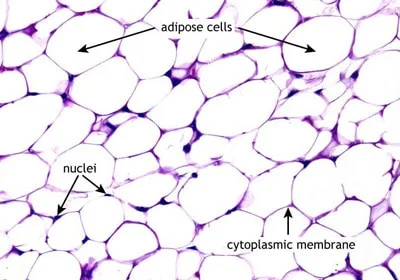
Adipose tissue pertains to fat, which is primarily made up of fat cells known as adipocytes. [1]
Adipose stem cells or “ASCs” are an source of therapeutic mesenchymal cells for younger patients or those seeking cosmetic treatments like stem cell breast treatment and stem cell facelifts. Unlike the limited quantities of bone marrow derived stem stem cells “BMSCs” The adipose tissue or “Fat Stem Cells” can be extracted in fairly large quantities using special mini-liposuction aspiration before they are expanded in a special stem cell lab for several days in vitro.[2] Adipose fat stem cells and Preadipocytes are useful in treatments since they have the ability to home and undergo osteogenic, adipogenic, chondrogenic, and even neurogenic differentiation using our proprietary growth medium. Adipose stem cells are also immunoprivileged and have virtually zero chance of rejection thus preventing any risk of getting graft-versus-host disease. [3]
Despite the promising results, however, fat stem cells and lipofilling can provide unpredictable graft retention rates unless enriched/cultured for several days. Without proper cell culturing the reabsorption rates can be very high varying from 40% to 85% [4]
Adipose Fat Cells Under Microscope
Adipose tissue can be found in pockets of fat near the lower abdomen and inner thigh regions only. The tissue is believed to have adult stem cells; thus, its common use in cosmetic stem cell therapies. The extraction and isolation of adipose “fat” stem cells are usually performed through a closed-system mini-liposuction and the expansion with cell culturing medium requires several days before they can be reintroduced to the patient for variety of treatments including peripheral neuropathy, heart attacks, strokes and Coronary artery disease (CAD).
To learn more about our Enriched Adipose tissue derived stem therapies please contact us today.
[1] ^ Harasymiak-Krzyżanowska, Izabela, Alicja Niedojadło, Jolanta Karwat, Lidia Kotuła, Paulina Gil-Kulik, Magdalena Sawiuk, and Janusz Kocki. 2013. Adipose tissue-derived stem cells show considerable promise for regenerative medicine applications. Cellular & molecular biology letters, no. 4 (August 14). doi:10.2478/s11658-013-0101-4. https://www.ncbi.nlm.nih.gov/pubmed/23949841
[2] ^ Mohammadi, Zahra, Jalil Tavakkol Afshari, Mohammad Reza Keramati, Daryoush Hamidi Alamdari, Meysam Ganjibakhsh, Azam Moradi Zarmehri, Ali Jangjoo, Mohammad Hadi Sadeghian, Masoumeh Arab Ameri, and Leila Moinzadeh. 2015. Differentiation of adipocytes and osteocytes from human adipose and placental mesenchymal stem cells. Iranian journal of basic medical sciences, no. 3. https://www.ncbi.nlm.nih.gov/pubmed/25945239
[3] ^ Salyutin, R V, K M Zapohlska, S S Palyanytsya, V M Sirman, and M F Sokolov. 2015. [Differentiation of mesenchymal stem cells of adipose tissue]. Klinichna khirurhiia, no. 3. https://www.ncbi.nlm.nih.gov/pubmed/26072548
[4] ^ Zanetti, Andrea S, Gregory T McCandless, Julia Y Chan, Jeffrey M Gimble, and Daniel J Hayes. 2013. In vitro human adipose-derived stromal/stem cells osteogenesis in akermanite:poly-ε-caprolactone scaffolds. Journal of biomaterials applications, no. 7 (June 24). doi:10.1177/0885328213490974. https://www.ncbi.nlm.nih.gov/pubmed/23796629
If you've seen people take ice baths or cold showers and wondered if they're onto… Read More
Immunomodulation stands at the forefront of biomedical research, steering the immune system's ability to fight… Read More
Stem cell research leads the charge in medical innovation, heralding revolutionary advances in regenerative medicine.… Read More
The blood-brain barrier (BBB) is a crucial shield for the brain, regulating the entry of… Read More
While peptide bonds are fundamental to protein structure, their direct relationship with stem cells lies… Read More
When discussing cutting-edge cancer treatments, NK cell therapy stands out due to its unique approach… Read More